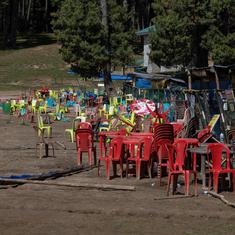Reading More Days at the Morisaki Bookshop, the much-awaited sequel to Satoshi Yagisawa’s heartwarming bestseller Days at the Morisaki Bookshop, feels like joining your friends for a summer reunion, catching up with familiar faces and asking them, “How have you been?” The novel opens with Takako, the protagonist, walking leisurely in Tokyo’s rather unusual neighbourhood of Jimbocho. Known for its “own quiet little world”, in the midst of the crazy bustle of the metropolis, the quaint streets of Jimbocho form a charming oasis for more than a hundred and seventy bookstores.
Sauntering towards the Morisaki Bookshop, Takako looks back on her life and recapitulates the changes she has experienced, giving the reader a fair idea of the prequel. She reminisces about her first visit to the bookstore: “At that time in my life, I was feeling desperate although the cause now seems insignificant when I look back on it.” The sequel traces the changes in Takako’s personality. Her voice brims with the confidence of a person who has overcome personal challenges and is ready to greet life with an open heart on a firm footing – all thanks to her former stay at the Morisaki Bookshop.
Endearing bond between booksellers and their customers
Morisaki Bookshop is a vintage store that specialises in modern Japanese literature. The two-storeyed wooden building, fragrant with musty aroma, stands cramped with piles of second-hand books stacked all over the place. The plot stays pivoted around the bookstore and the people associated with it. Takako’s uncle Satoru, the third-generation proprietor of the bookshop, is eccentric yet immensely “well-liked”. The sequel sees him reunite with his long estranged wife Momoko, who also helps him with the bookstore.
Takako keenly observes all the visitors, who despite their unusualness have grown on her with time. So much so that she secretly imagines their everyday lives and the prolonged absence of any regular customer worries her. The clientele spans a range of odd people, especially the elderly, who frequent the store with their distinct drives – connoisseurs of rare and antique books, collectors of first editions, book brokers, author’s seal enthusiasts, genuine book lovers in worn-out clothes and of course, the regular browsers.
The setting of the bookstore in Jimbocho is interesting too. This book-town in Tokyo is famous for used books, antiques and curios. With a history dating back to the early 1900s, it is a paradise for book lovers and is credited with popularising book-reading culture in Japan. Yagisawa pays a worthy tribute to the rich history of Jimbocho.
The novel, quite like its prequel, plays out like a slice-of-life anime where each character renders a distinct hue to the canvas. Despite the health struggles emanating from a sedentary lifestyle, Satoru is ever-so-dedicated to his work. He is seen sharing episodes from the personal lives of authors and trivia about their works. References to luminaries of Japanese literature like Tanizaki, Dazai, Ango and Oda enrich the reading experience. Even Takako, while filling in for Satoru on a certain weekend experiences the delight of book-keeping as she contemplates, “I had the peculiar feeling then that I had become one with the bookshop. I could feel my sense of self begin to dissolve and my consciousness expand.” Indeed, the bonds between readers and writers transcend time and geography. Bookstores help build these bonds and preserve them; and the proliferation of these bonds can have a powerful impact on communities and nations.
Books, lovers and book lovers
The romantic subplots not only exude warmth but also explore the deeper meaning of relationships in the context of personal traumas. Takako’s innocuous inter-generational banters with Satoru are charming and funny, while Momoko’s relationship with her has a maternal streak to it. In the company of book lovers, Takako’s boyfriend Wada rediscovers his long-lost desire to write a novel, and Takako’s friend Tomo looks for a phantom book for his love interest. Flipping through the pages, you are reminded that there are books to be discovered, books to be penned, books that provide refuge and healing, books that talk about books, and most importantly books that serve as a bridge to the self.
And as life goes on, our experiences diversify, we form new relationships while letting go of a few old ones, we resist some changes and submit to fate on some occasions – such is the web of human existence. The simple, yet heart-to-heart conversations among the characters traverse this web, intertwined with the fragility of life. The reader gets to see the full gamut of sentiments.
Yagisawa received the Chiyoda Literature Prize in 2008 for his debut novel Days at Morisaki Bookshop. Eric Ozawa’s translation is crisp and makes this comforting novel a breezy read. Ozawa aptly captures the mysterious and inexpressible joy of books and bookshops in the translator’s note, “The books lie ahead of us; they seem to know things we do not…Who knows what else we’ll find?” Each book we read is a step forward in this never-ending quest. Here in the world of the Morisakis in Jimbocho, many tender stories and “thoughts and hopes and feelings of a great many people” wait to be discovered by the readers.

More Days at the Morisaki Bookshop, Satoshi Yagisawa, translated from the Japanese by Eric Ozawa, Manilla Press.










